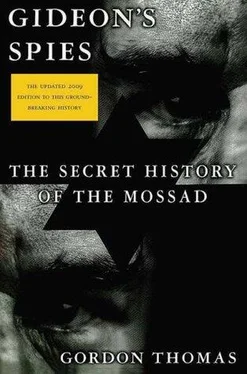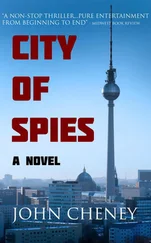Gordon Thomas - Gideon's Spies
Здесь есть возможность читать онлайн «Gordon Thomas - Gideon's Spies» весь текст электронной книги совершенно бесплатно (целиком полную версию без сокращений). В некоторых случаях можно слушать аудио, скачать через торрент в формате fb2 и присутствует краткое содержание. Город: New York, Год выпуска: 2009, ISBN: 2009, Издательство: Thomas Dunne Books, Жанр: История, на английском языке. Описание произведения, (предисловие) а так же отзывы посетителей доступны на портале библиотеки ЛибКат.
- Название:Gideon's Spies
- Автор:
- Издательство:Thomas Dunne Books
- Жанр:
- Год:2009
- Город:New York
- ISBN:978-0-312-53901-6
- Рейтинг книги:4 / 5. Голосов: 1
-
Избранное:Добавить в избранное
- Отзывы:
-
Ваша оценка:
- 80
- 1
- 2
- 3
- 4
- 5
Gideon's Spies: краткое содержание, описание и аннотация
Предлагаем к чтению аннотацию, описание, краткое содержание или предисловие (зависит от того, что написал сам автор книги «Gideon's Spies»). Если вы не нашли необходимую информацию о книге — напишите в комментариях, мы постараемся отыскать её.
Gideon’s Spies
Gideon's Spies — читать онлайн бесплатно полную книгу (весь текст) целиком
Ниже представлен текст книги, разбитый по страницам. Система сохранения места последней прочитанной страницы, позволяет с удобством читать онлайн бесплатно книгу «Gideon's Spies», без необходимости каждый раз заново искать на чём Вы остановились. Поставьте закладку, и сможете в любой момент перейти на страницу, на которой закончили чтение.
Интервал:
Закладка:
When the critically injured Diana arrived at the Saleptrie Hospital, Monique was on duty in the emergency room to ensure no media entered. Shortly afterward, Diana was pronounced dead. She was draped in a clean gown and taken to a side room. Two nurses washed her body. One would later tell a reporter, “She looked so beautiful as if she was asleep.”
The pathologist, Dominique Lecomte, arrived to find a scene of controlled chaos: “There were people around who you would not find in an operating room,” she said later. They included two senior diplomats from the Paris British Embassy, senior officials from the French Ministry of Justice, and the chief of the Paris police. The diplomats and the French officials stood in separate groups, whispering among themselves. Standing apart from the others was a member of the MI6 team in Paris who had been tracking Diana after her determined campaign against land mines. In London government circles, she had been called “a loose cannon.” He was there to ensure there would be no obstacles to what Professor Lecomte was told “must be the swift transfer of Lady Di’s body back to England. The order comes from high up in London.”
Professor Lecomte asked for the body to be transferred to a side room adjoining the operating theater so she could conduct an autopsy. That was the moment the first conspiracy theory took root. The hospital had a fully equipped mortuary where an autopsy could have been performed. Had it not been used because transferring her there would delay matters? Alone with the body, Professor Lecomte began her “partial autopsy and partial embalming.” Highly experienced though the pathologist was, even a “partial embalming” required time after she had performed a “partial autopsy.” This would have required Professor Lecomte to remove a number of Diana’s organs—probably including her heart and kidneys. She would also have removed organs from Diana’s pelvic area. This would later further the speculation that Professor Lecomte had removed any evidence that Diana was pregnant. The pathologist then performed the “partial embalming,” which French law requires before a body can leave the country. Even partial embalming is usually left to a mortician trained in the process. Skill is required in correctly diluting the formaldehyde so as not to discolour the skin or leave an unpleasant chemical odor.
In the years following the events in the early hours of that Sunday night, August 31, 1997, Professor Lecomte has refused to explain her crucial role. “The decision to embalm Diana’s body would have tainted any samples taken at the postmortem in London. As a result the issue of pregnancy would have been covered up,” insisted Mohamed al-Fayed, the father of Dodi, to the author.
Mossad’s files on the deaths of Diana and Dodi contained detailed information on the role played by the CIA, MI6, MI5, and French intelligence. They answered speculation that Henri Paul was being used by MI6 to keep a discreet eye on Diana as her affair continued to attract world attention and contained details of the thirteen separate bank accounts held by Henri Paul for money he received from French intelligence. The former Israeli intelligence officer, Ari Ben-Menashe, had offered to provide Mohamed al-Fayed with copies of the files, claiming “they are the smoking gun that could reveal the full extent of the intelligence role in the deaths of Dodi and Diana,” he stated to the author. He had asked for £750,000 for the files. Al-Fayed refused.
In Tel Aviv, Meir Dagan decided there would be no benefit to Mossad in providing Lord Stevens with access to the service’s files. In that first week of 2005, he then had more important matters on which to focus.
Once more the specter that had haunted Dagan’s predecessors had surfaced. The FBI had reopened its investigation to try and establish the identity of Mega, Mossad’s deep-penetration agent high-level spy in Washington. He had originally been identified as working within the Clinton administration. But the FBI now believed he had successfully managed to conceal himself to secure a place in the Bush presidency. Like his predecessors, Dagan was probably the only spy chief in Israel who knew the true identity of his prized informer (see chapter 5, “Gideon’s Nuclear Sword,” pp. 100–2).
In the aftermath of George Bush being returned to the White House for another four-year term, FBI director Robert Mueller had briefed National Security adviser Condoleezza Rice—soon to become secretary of state—that Mega was the conduit for how highly sensitive policy documents on Iran had been passed to Israel. Mueller had told Rice that Mega would now be more important than ever for Israel as Bush began to formulate his policy toward the Middle East.
The FBI had already spent more than a year covertly investigating, using the latest electronic surveillance equipment, a Pentagon official, Larry Franklin, who was a senior analyst in a Pentagon office dealing with Middle East affairs. Franklin formerly worked for the Defense Intelligence Agency.
The Defense Department had confirmed the investigation, adding that Franklin worked in the office of defense undersecretary Douglas J. Feith, an influential aide to defense secretary Donald Rumsfeld.
The FBI had publicly said their investigation centered on whether Franklin passed classified U.S. material on Iran to the American-Israel Public Affairs Committee. The AIPAC is a highly influential Israeli lobby in Washington. Like Franklin, it had been swift to deny “any criminal conduct.” In Israel, Ariel Sharon had taken the unusual step of issuing a similarly worded statement insisting: “Israel does not engage in intelligence activities in the United States.”
Meir Dagan knew better. The United States had remained a prime target for Mossad operations after the 1985 conviction of navy analyst Jonathan Pollard on charges of passing secrets to Israel.
The FBI now believed Mossad had been responsible for how America’s nuclear secrets, stored on computer drives, had been stolen from Los Alamos. The drives were each the size of a deck of playing cards and kept in the facility’s most secure, password-protected vault in X-Division, twenty feet below the Mexican mountains.
The theft was discovered after a massive forest fire threatened the area and scientists were ordered to enter the vault to remove the drives. But because of the intensity of the fire, Los Alamos was closed down for ten days, which meant a full-scale search for the drives was launched only after this period. The drives were designed to fit into laptop computers carried by members of the Nuclear Emergency Search Team (NEST) on permanent readiness to fly to the scene of any nuclear incident within the United States. NEST squads would use the highly detailed technical information on the drives to disarm and dismantle nuclear devices. The drives had been checked as all-present in an inventory taken in April 2002.
When the FBI finally arrived on the scene in May that year, their first suspicion was that a terrorist group had carried out the theft. But then, three months later, they discounted this when the drives were found behind a photocopier in another Los Alamos laboratory. In a report to Bill Richardson, the then energy secretary responsible for the lab, and its security chief, Eugene Habinger, the FBI concluded the theft was the work of a highly professional foreign intelligence service “like Mossad.”
Now, three years later, the agency had not changed its view, Mueller told Condoleezza Rice. He also remained certain that somewhere within the Bush administration, Mega was securely entrenched. It was not a comfortable thought for the FBI director.
The Los Alamos theft had been prepared by the director general of CSIS, Qiao Shi. As well as being China’s longest serving and most senior spy master, the eighty-two-year-old Qiao Shi was also chairman of the Chinese National Assembly since 1993 and the security chief of the Chinese Communist Party. It effectively made him overall intelligence supreme of the entire Chinese spying apparatus.
Читать дальшеИнтервал:
Закладка:
Похожие книги на «Gideon's Spies»
Представляем Вашему вниманию похожие книги на «Gideon's Spies» списком для выбора. Мы отобрали схожую по названию и смыслу литературу в надежде предоставить читателям больше вариантов отыскать новые, интересные, ещё непрочитанные произведения.
Обсуждение, отзывы о книге «Gideon's Spies» и просто собственные мнения читателей. Оставьте ваши комментарии, напишите, что Вы думаете о произведении, его смысле или главных героях. Укажите что конкретно понравилось, а что нет, и почему Вы так считаете.












